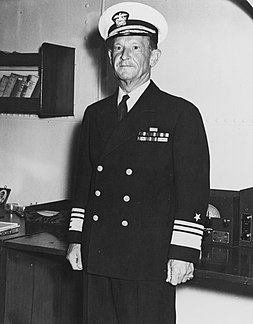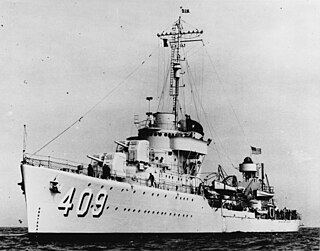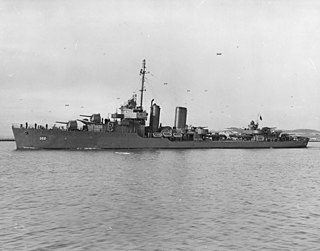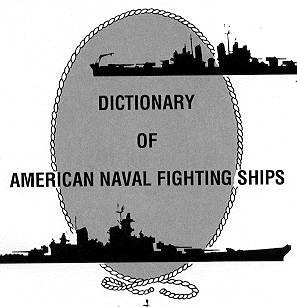Lieutenant Commander Willford Milton Hyman (16 August 1901 – 7 May 1942) was an officer in the United States Navy during World War II.

The United States Navy (USN) is the naval warfare service branch of the United States Armed Forces and one of the seven uniformed services of the United States. It is the largest and most capable navy in the world and it has been estimated that in terms of tonnage of its active battle fleet alone, it is larger than the next 13 navies combined, which includes 11 U.S. allies or partner nations. with the highest combined battle fleet tonnage and the world's largest aircraft carrier fleet, with eleven in service, and two new carriers under construction. With 319,421 personnel on active duty and 99,616 in the Ready Reserve, the Navy is the third largest of the service branches. It has 282 deployable combat vessels and more than 3,700 operational aircraft as of March 2018, making it the second-largest air force in the world, after the United States Air Force.

World War II, also known as the Second World War, was a global war that lasted from 1939 to 1945. The vast majority of the world's countries—including all the great powers—eventually formed two opposing military alliances: the Allies and the Axis. A state of total war emerged, directly involving more than 100 million people from over 30 countries. The major participants threw their entire economic, industrial, and scientific capabilities behind the war effort, blurring the distinction between civilian and military resources. World War II was the deadliest conflict in human history, marked by 50 to 85 million fatalities, most of whom were civilians in the Soviet Union and China. It included massacres, the genocide of the Holocaust, strategic bombing, premeditated death from starvation and disease, and the only use of nuclear weapons in war.
Born in Pueblo, Colorado, Hyman graduated from the United States Naval Academy in 1924. He first served in battleship USS New Mexico (BB-40), and in the years before World War II, was assigned to many ships and a variety of shore stations, including the Office of Naval Operations. He assumed command of destroyer USS Sims (DD-409) 6 October 1941. After convoy escort duty in the Atlantic, Sims moved to the Pacific in early 1942.

Pueblo is a home rule municipality that is the county seat and the most populous city of Pueblo County, Colorado, United States. The population was 106,595 in 2010 census, making it the 267th most populous city in the United States and the 9th largest in Colorado. Pueblo is the heart of the Pueblo Metropolitan Statistical Area, totaling over 160,000 people and an important part of the Front Range Urban Corridor. As of 2014, Pueblo is the primary city of the Pueblo–Cañon City combined statistical area (CSA) totaling approximately 208,000 people, making it the 134th largest in the nation.

The United States Naval Academy is a four-year coeducational federal service academy adjacent to Annapolis, Maryland. Established on 10 October 1845, under Secretary of the Navy George Bancroft, it is the second oldest of the United States' five service academies, and educates officers for commissioning primarily into the United States Navy and United States Marine Corps. The 338-acre (137 ha) campus is located on the former grounds of Fort Severn at the confluence of the Severn River and Chesapeake Bay in Anne Arundel County, 33 miles (53 km) east of Washington, D.C. and 26 miles (42 km) southeast of Baltimore. The entire campus is a National Historic Landmark and home to many historic sites, buildings, and monuments. It replaced Philadelphia Naval Asylum, in Philadelphia, that served as the first United States Naval Academy from 1838 to 1845 when the Naval Academy formed in Annapolis.

A battleship is a large armored warship with a main battery consisting of large caliber guns. During the late 19th and early 20th centuries the battleship was the most powerful type of warship, and a fleet of battleships was considered vital for any nation that desired to maintain command of the sea.
In May, as the Japanese attempted to extend their conquest to Port Moresby, the ship was operating with oiler USS Neosho (AO-23) in a fueling group for Admiral Frank Jack Fletcher's aircraft carriers. While the carrier fleets maneuvered for position, Japanese planes found Neosho and Sims in the Coral Sea; and, thinking they were carrier and escort, attacked in strength. After Lt. Comdr. Hyman fought his ship through 2 air raids with great skill, 36 Japanese planes attacked the 2 ships. Sims took three 500-lb. bomb hits in this third attack. From the time the first bomb that hit the Sim's had exploded to the time she was sunk was a total of 48 seconds, leaving only 13 survivors. The sacrifice of his ship and Neosho had much to do with saving the Navy's carriers in the widely separated engagements known as the Battle of the Coral Sea. The Japanese blunder in mistaking the Sims for a cruiser and the flat top Neosho as an American carrier, diverted much needed air power and other resources from the Battle of Midway, just a few days away. As the Sims was sinking, with all but the forward 5" gun submerged, the Sims continued to fire her gun even though the gun crew knew they were about to die. The actions of Commander Hyman and his crew were upholding the finest traditions of the U.S. Navy. Lieutenant Commander Hyman received the Navy Cross for his heroic service.

Japan is an island country in East Asia. Located in the Pacific Ocean, it lies off the eastern coast of the Asian continent and stretches from the Sea of Okhotsk in the north to the East China Sea and the Philippine Sea in the south.

Port Moresby, also referred to as Pom City or simply Moresby, is the capital and largest city of Papua New Guinea and the largest city in the South Pacific outside of Australia and New Zealand. It is located on the shores of the Gulf of Papua, on the south-western coast of the Papuan Peninsula of the island of New Guinea. The city emerged as a trade centre in the second half of the 19th century. During World War II it was a prime objective for conquest by the Imperial Japanese forces during 1942–43 as a staging point and air base to cut off Australia from Southeast Asia and the Americas.

USS Neosho (AO-23) was a Cimarron-class fleet oiler serving with the United States Navy, the second ship to be named for the Neosho River in Kansas and Oklahoma.
USS Hyman (DD-732) was named for him.


















